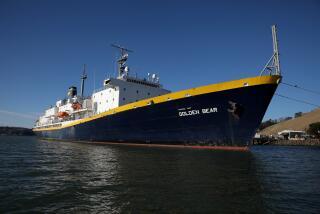Sonar Analyst May Resolve Key Question
- Share via
PEARL HARBOR, Hawaii — With today’s scheduled testimony of a senior enlisted sailor responsible for analyzing sonar data, the Navy’s court of inquiry into the Greeneville collision hopes to resolve what has emerged as the last big mystery of the tragedy:
How could an experienced submarine sailor with an excellent record fail to tell his captain that a vessel was close and getting closer to the exact spot where the Greeneville planned to execute a rapid surfacing maneuver?
The question is so troubling to Adm. Thomas Fargo, commander of the Pacific Fleet, that he granted testimonial immunity to Petty Officer 1st Class Patrick Thomas Seacrest to ensure that he will talk candidly to the three admirals on the court.
The Feb. 9 collision between the Greeneville and the Japanese fishing vessel Ehime Maru, which killed nine crew members and students aboard the trawler, has raised numerous questions for the Navy.
But none is more vexing than the alleged failure of Seacrest to tell the sub’s captain, Cmdr. Scott D. Waddle, that his analysis of sonar data appeared to indicate a ship within about 2,000 yards of the submarine.
Traveling at 11 knots, the Ehime Maru closed that distance in the approximately five minutes that it took Waddle to complete his periscope check, order the submarine to dive, and then order an “emergency blow” that sent the sub rocketing to the surface.
The investigation’s emphasis on Seacrest is an indication of how dependent the sea service is on its senior enlisted personnel. If sergeants are said to run the Army, then higher-ranking petty officers do the same for the Navy.
Seacrest, a 14-year veteran from New Hampshire, has served on three previous submarines and has been a sub school instructor.
On the Greeneville, he was the fire-control technician, standing just a few feet from the captain in the control room. His primary duty was to analyze sonar data and advise the captain and other officers of any ships in the immediate area.
Seacrest has told Navy and National Transportation Safety Board investigators that civilian VIPs hindered him from putting his finding in a written log, that he thought Waddle had the same information directly from the sonar operators, and that he dismissed the 2,000-yard finding after Waddle saw nothing that close during a periscope inspection.
But 10 days of testimony has suggested that Waddle missed seeing the Ehime Maru because his periscope inspection was too brief, the sky was too hazy and the sea was too choppy.
Testimony showed that the sonar operators were inexperienced, inadequately supervised, frequently swapped jobs and were not given enough time by Waddle to take fresh readings before the rapid ascent.
So eager is the Navy to have Seacrest tell his story--for the benefit of the court and the outraged Japanese public--that Fargo granted him testimonial immunity even though he had not requested it. Such immunity means Seacrest’s words cannot be used against him if the Navy later court-martials him.
Rear Adm. Charles H. Griffiths Jr. testified that even after interviewing Seacrest, he has trouble understanding why Seacrest withheld the “close contact” data.
“This is key information and it didn’t get to the commanding officer [Waddle] or officer of the deck” Lt. j.g. Michael J. Coen, Griffiths said. “It should have.”
More to Read
Sign up for Essential California
The most important California stories and recommendations in your inbox every morning.
You may occasionally receive promotional content from the Los Angeles Times.













